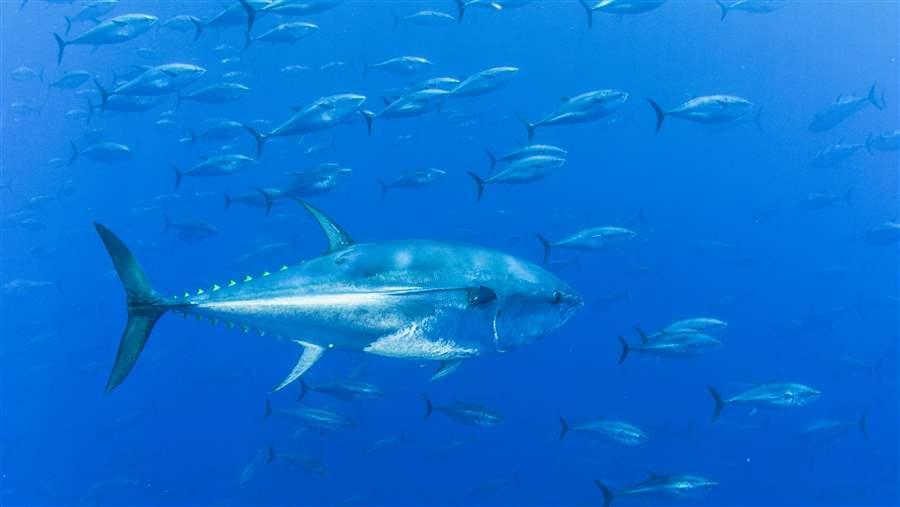Has Eastern Atlantic & Mediterranean Bluefin Tuna Recovered? Not Yet.
Eastern population shows signs of growth, but scientists warn of major uncertainty in new assessment

The bluefin tuna population in the eastern Atlantic Ocean and Mediterranean Sea has increased in response to science-based management but is not yet fully recovered.
© Manfred BortoliDespite improvements in the numbers of eastern Atlantic and Mediterranean bluefin tuna, a new stock assessment concludes that it’s too early to declare this once severely depleted population fully rebuilt. The determination by the International Commission for the Conservation of Atlantic Tunas (ICCAT) comes as many groups, including The Pew Charitable Trusts, had expected to be celebrating a full recovery of the stock, which had improved after less than a decade of science-based fishery management policies.
For eastern bluefin, scientists have competing theories on how to forecast how many young fish in the population will survive to age 1—a calculation called future recruitment. For the assessment, the scientists ran high, medium, and low recruitment scenarios and noted that, if the high scenario is correct, the stock could still be considered overfished. If the low or medium calculation is accurate, the stock may already have recovered.
The new assessment was meant to resolve a large amount of scientific uncertainty over the stock status and was arguably the most complicated assessment ever undertaken for any bluefin species. Still, ICCAT scientists were unable to address many of the outstanding issues and remain concerned that their estimates of the stock’s abundance could be overly optimistic. This stems from questions about the accuracy of newer data sources, such as a new survey of larval bluefin in the Mediterranean Sea, which is driving much of the assessed population growth, coupled with worry that the estimate was further skewed by a single strong year of bluefin reproduction. Other concerns are that they included data only through the 2015 fishing season; vessels landed much higher catches in 2016 and this year, which almost certainly affected the eastern population overall. And, as always, scientists’ future projections carry even more uncertainty than does their estimate of the current status.
Perhaps of most concern are signs that ICCAT may be returning to a riskier management approach, first by agreeing in 2014 to increase the eastern bluefin quota by 72 percent (to 23,155 metric tons) over three years, and then by voting last year to raise it an additional 500 metric tons, again pushing the quota above the scientifically advised limit.
In addition to the pressure that a sudden spike in catch can place on the stock, a new economic analysis indicates that raising bluefin quotas can also be bad for business: When the global supply of bluefin and its market substitutes, such as fresh bigeye tuna, goes up, the price of all of those species drops. Further, for several tuna products, the decrease in price is greater than the increase in supply, meaning that even if those fishermen can sell more fish, their overall revenue would decrease.
While ICCAT scientists meet in Madrid through Oct. 6 to develop their advice for 2018 and possibly beyond, governments already have key information to help them form their management positions this year: Scientists have not confirmed the recovery of eastern bluefin; the assessment results are highly uncertain and likely overly optimistic on population estimates, and tuna prices have suffered due to the significant increases in eastern bluefin catch in recent years.
While the scientific advice provides the bounds for quota negotiations, it is the responsibility of fishery managers to protect the full recovery and long-term health of Atlantic bluefin and related fisheries. This year, the science and economics clearly point to the need for a conservative approach to management. This includes setting quotas for the coming years that are based on a precautionary interpretation of the scientific advice, while also making progress on the development of harvest strategies, an innovative system of fisheries management that will transition ICCAT to a more effective, predictable, and stable approach to bluefin in the future.
Amanda Nickson directs The Pew Charitable Trusts’ global tuna conservation work.


More Tuna Isn’t Always Better
New study looks at what happens to tuna prices when bluefin supply spikes


The Science Is Critical for Atlantic Stocks
Backsliding by ICCAT on science-based management threatens valuable fisheries, including prized bluefin tuna


Netting Billions: A Valuation of Tuna in the Atlantic Ocean


Harvest Strategies
Understanding how the process works






